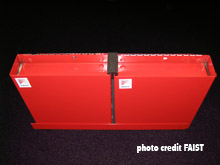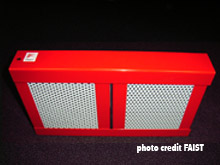With regard to metallic sound insulation panels (also called soundproofing panels) used for current applications in industrial soundproofing such as building an enclosure (acoustic hood) - structure enveloping a sound source (machine), designed to protect the environment of this sound source (machine) -, they generally consist of an outer casing (usually made of non-stainless steel, most of the time: with paint) and of an absorbing filling (quite often: mineral wool) covered by a surfacing (mostly: a fiber glass) and also a perforated protection (mostly: galvanized steel). For the outer casing, a powder coating usually provides the best possible protection against corrosion: classification up to C5 according to ISO 12944.

sound insulation panel for enclosure (sounproofing hood) |

sound insulation panel |
In some cases, the envelope of acoustic insulation panels of cabins can be made of stainless steel (SS 304, SS 316) or aluminum.
As required, the absorbing filling may consist of acoustic foam or polyester wool and, for some applications, be protected by a waterproof surfacing (polyurethane film and for extreme cases: painting).
In order to increase the sound reduction index in a given frequency range, an intermediate plate (usually made of steel) and an additional spacing absorbent layer may be inserted into the acoustic insulation panels, the performance of such insulation panels being based on the double shell effect.
For specific cases, a damping material (viscoelastic) can be incorporated.
Acoustic performance of sound insulation panels for cabins (in terms of sound reduction index) is very frequency dependent, being related mainly (besides the quality of the joint between panels basing their airtightness ):
- for panels with simple shell effect: mainly to the total mass density
- for panels with double shell effect: mainly to the mass density of each of the facings and to their spacing (the mass density of the inner absorbing lining may also be accounted if significant)
The prediction of acoustic performance of the partitions of an enclosure can be performed with the simulation software SILDIS®.
The verification of acoustic performance of the partitions of an enclosure can be conducted in accordance with ISO 140-3 Acoustics - Measurement of sound insulation in buildings and of building elements - Part 3: Laboratory measurements of airborne sound insulation of building elements.
ITS sells metal acoustic insulation panels for enclosures / soundproofing hoods for all kinds of applications.
Spread the word !